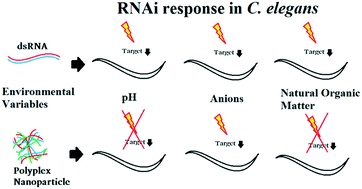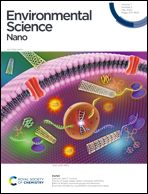Efficacy of chitosan/double-stranded RNA polyplex nanoparticles for gene silencing under variable environmental conditions†
Abstract
We investigated the ability of chitosan/double-stranded RNA polyplex nanoparticles to silence genes in Caenorhabditis elegans in different environmentally analogous media. Using fluorescence microscopy, we were able to rapidly assess gene knockdown and dsRNA uptake under numerous conditions. Scanning transmission electron micrographs of polyplexes confirms heterogeneous distribution of chitosan and RNA in single particles and a wide range of particle morphologies. High pH and the presence of natural organic matter inhibited the ability of polyplex nanoparticles to silence genes, but were unaffected by the presence of inorganic nitrate and phosphate. Environmental media did not affect particle size in any specific pattern, as determined by dynamic light scattering and fluorescence correlation spectroscopy. The efficacy of polyplexes seems to be closely tied to zeta potential, as all treatments that resulted in a net negative zeta potential (high pH and high natural organic matter) failed to achieve gene knockdown. These results support earlier work that emphasized the importance of charge in gene carriers and will aid in the development of effective gene silencing biological control agents.

- This article is part of the themed collection: Nano-bio interactions


 Please wait while we load your content...
Please wait while we load your content...
